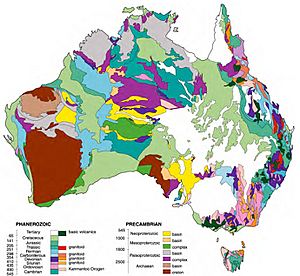Australian Shield facts for kids
Quick facts for kids Australian ShieldStratigraphic range: Archean |
|
|---|---|
| Type | Shield |
| Area | 700,000 km2 |
| Thickness | 4.5 kilometres (2.8 mi) |
| Location | |
| Region | Oceania |
| Country | |
The Australian Shield is a huge, very old part of the Earth's crust. It covers more than half of the continent of Australia. You might also hear it called the Western Australian Shield or the Western Plateau.
The word "shield" is used because it's like a giant, strong shield made of rock. This rock was once melted deep inside the Earth. Over billions of years, it cooled down and became solid. The Australian Shield is about 4.5 kilometers (2.8 miles) thick. It is incredibly old, estimated to be between 2.8 and 3.5 billion years old! In some places, younger rocks have formed on top of this ancient shield.
Contents
Where is the Australian Shield Located?
The Australian Shield covers the western part of Australia. Imagine a line running from the northern coast (Arnhem Land) down to the southern coast (Eyre Peninsula). Everything to the west of this line is part of the shield.
How High is the Australian Shield?
This huge area is mostly a plateau. A plateau is a large, flat area of land that is higher than the land around it. The Australian Shield usually sits between 305 and 460 meters (1,000 to 1,500 feet) above sea level.
What are the Main Parts of the Shield?
The shield is not one smooth piece. It's broken into several large sections called blocks. Two of the most important blocks are called cratons. Cratons are very old and stable parts of the Earth's crust.
- The Pilbara Craton is in the north.
- The Yilgarn Craton is in the southwest.
These two cratons are the oldest parts of the shield. They are both more than 2.3 billion years old!
Uplands and Lowlands of the Shield
Some of these blocks have been pushed up, forming higher areas called uplands. Other blocks have sunk down, creating lower areas called lowlands or basins.
- Lowlands include:
* The Great Sandy Desert * The Gibson Desert * The Great Victoria Desert * The Nullarbor Plain (This is a dry, flat limestone area with almost no trees. "Nullarbor" means "no trees" in Latin.)
- The Great Artesian Basin is a huge underground water source. It sits between the Western Australian Shield and the Great Dividing Range.
- Uplands include mountain ranges like:
* The Hamersley Range in Western Australia. * The Wunaamin Miliwundi Ranges in Western Australia. * The Darling Range near Perth in Western Australia. * The MacDonnell Ranges in the Northern Territory. * The Stuart Range and Musgrave Ranges in South Australia.
Unique Rock Formations
Over millions of years, wind and water have worn away parts of the shield. This erosion has created amazing, isolated rock formations. These are often called mesas or buttes. You can see these striking shapes in places like the Kimberley and Pilbara areas of Western Australia, and in Arnhem Land in the Northern Territory.
See also
 In Spanish: Escudo australiano para niños
In Spanish: Escudo australiano para niños


